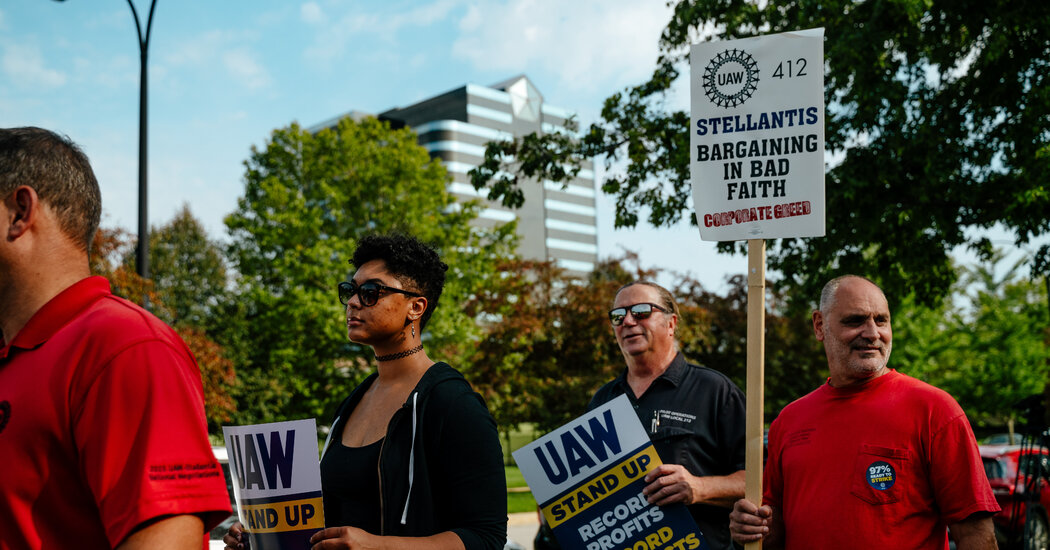
The United Automobile Workers strike against the Michigan automakers would seem to be nothing but good news for Tesla, the electric vehicle maker that has upended the industry and stolen customers from Ford Motor, General Motors and Stellantis, which owns Jeep and Ram.
Tesla, unencumbered by an activist union, can take advantage of the work stoppages to add to its substantial lead in battery technology and software. As the three established automakers face increases in labor costs and struggle to master electric vehicles, Tesla can lower car prices because it is much more profitable than most automakers.
However, the U.A.W.’s determination to secure a big victory for its members, amid a nationwide resurgence in union activism, harbors risks for Tesla and Elon Musk, its chief executive, who has attacked and ridiculed unions on his social media network, X, formerly Twitter.
The U.A.W., which has failed to organize Tesla’s factory workers in the past, is gearing up for another attempt, a top union official said.
“There is a group of Tesla workers who are actively talking about forming a union and creating the best representation they can for themselves and their co-workers through collective bargaining,” said Mike Miller, the director of the U.A.W.’s Region 6, which includes California and Nevada, where Tesla makes cars and batteries. Tesla also has a large factory in Austin, Texas, not too far from a unionized G.M. factory in the Dallas-Fort Worth area.
In an interview, Mr. Miller declined to provide more details or identify the Tesla workers, saying they needed time to prepare before going public. This union organizing effort is separate from a campaign at a Buffalo plant where Tesla makes electric vehicle chargers and employs data entry workers.
But as representatives of the national union demand 40 percent wage increases from the Detroit automakers, along with significant gains in benefits, they are certainly thinking about the signal that any deal would send to nonunion workers at Tesla.
“Clearly the narrative out there is that this can’t be good for the Big Three, and if it’s not good for the Big Three, it’s good for Tesla,” said Rahul Kapoor, a professor of management at the Wharton School of the University of Pennsylvania.
But he added, “If I’m an autoworker with wages lower than what Ford and G.M. are paying, and I hear there is a substantial increase, it’s very likely I would want to take that into account.”
The president of the U.A.W., Shawn Fain, fired a warning shot at Mr. Musk Sunday on CBS News’s “Face the Nation.”
“Most of these workers in those companies are scraping to get by so that greedy C.E.O.s and greedy people like Elon Musk can build more rocket ships and shoot theirself in outer space,” he said.
A lot has changed since 2016, when a group of workers at Tesla’s auto assembly plant in Fremont, Calif., began an organizing drive that never acquired enough momentum to come to a vote.
Back then, Tesla was a struggling upstart flirting with bankruptcy. Now, Tesla dominates the market for electric vehicles, with a 60 percent share in the United States. It is worth vastly more on the stock market than the three established U.S. automakers combined. It is arguably in a better position to reward workers than its rivals.
But labor organizing is arduous. Activists must get at least 30 percent of workers to sign union cards and force a vote overseen by the National Labor Relations Board. Companies often do all they can to dissuade workers from joining, hiring lawyers and consultants who specialize in defeating union campaigns.
Even if a majority of workers cast ballots in favor of a union, winning pay increases and better benefits comes only after negotiations that can drag for years.
Tesla, with a profit margin of about 11 percent, would be a tempting target for unions. Its stronger financial performance has allowed it to significantly cut car prices, making it harder for the established carmakers to gain ground in electric vehicles.
The climate for organized labor is better than it has been for years. President Biden is a big supporter of unions. In August, United Parcel Service employees won their biggest raises ever in a contract negotiated by the International Brotherhood of Teamsters.
Tesla did not respond to a request for comment, but Mr. Musk seemed to acknowledge the union threat last week, saying on X that his workers were better off than employees of G.M., Ford and Stellantis. “We pay more than the U.A.W.,” he said, although he added that “performance expectations are also higher.”
The traditional automakers quarreled with Mr. Musk’s math, saying that they pay their workers substantially more. Ford says its hourly employees make an average of $112,000 per year including benefits, compared with about $90,000 at Tesla.
Tesla workers may lose their stock options if they are fired or forced to quit because of injury or poor health. Stock awards fluctuate in value along with Tesla’s share price.
Any union drive would face forceful opposition from Mr. Musk. The National Labor Relations Board has found that Mr. Musk illegally threatened employees in 2018 by implying they would lose their stock options if they voted to unionize. The labor board also found that Tesla illegally fired one of the lead organizers.
Without doubt, the strike poses huge risks for the Detroit automakers, which were slow to take Tesla seriously and stand to lose precious time they need to catch up.
“The real winner in the U.A.W. strike will likely be the auto company that has been winning all along,” said Gary Black, managing partner of the Future Fund, an investment firm that owns Tesla stock, said on X.
However, any schadenfreude among Tesla investors could be brief.
“The strike could be a bellwether,” said Mr. Eckstein of Villanova. “It’s a hot time in the labor movement.”
RELATED POSTS
View all


